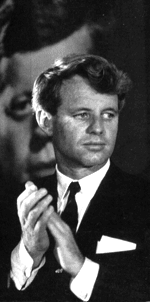
In its program "Unsolved History--The RFK Assassination,", directed by Robert Erickson, the Discovery Channel repeatedly omits critical facts refuting the tired old refrain that Sirhan Sirhan is guilty as the lone assassin of Senator Robert F. Kennedy. As Sirhan's attorney since 1994, I must point out that the facts are otherwise.
The LAPD admits that seven bullets were recovered from victims, asserts that one bullet was lost in the ceiling and acknowledges that the capacity of the co-called Sirhan revolver is eight bullets. Obviously, if any additional bullets were found on the crime scene, they would confirm that a conspiracy was afoot and that multiple shooters fired guns in the Ambassador Hotel's pantry on June 5, 1968 in RFK's presence. The program's producers admit that FBI files include photographs described as depicting bullet holes in the pantry door frame and center divider. LAPD defender Dan Moldea is shown objecting that the FBI was misled by a patrolman's circles around these holes. When retired FBI agent William Bailey rejoins that he himself saw bullets in these holes as the first agent on the scene, former LAPD Chief Daryl Gates replies he saw no such bullets when inspecting the removed (and then destroyed) pantry panels and door frames. The producers then end the program by asserting that the matter can never be fully resolved because it depends on nothing more than a dispute between Bailey and Gates about their own observations. Not so! An AP Wirephoto dated June 5, 1968 shows a police technician inspecting a "bullet hole" in the pantry door frame, and a blowup clearly shows an actual bullet lodged in the hole. The "unsolved mystery" is conclusively solved: an extra bullet embedded in the pantry crime scene demonstrates that multiple guns were being fired and that RFK died at the hands of a genuine conspiracy the existence of which was covered up by the prosecution. It would have been so simple to show the audience these photographs. Why were they omitted?
The LAPD was very sensitive about critical case-related photographs. Department files confirm that in August of 1968, officers connected with the secretive unit handling the RFK case actually burned 2,410 such photographs in an incinerator at County General Hospital. Police records also confirm that the LAPD acted as though two weapons were recovered from the assassination scene, obtaining test bullets from both resolvers by June 6, 1968. Significantly, one of these guns had been in police custody before the assassination and was destroyed less than a month later. At trial, the prosecution then falsely asserted that this weapon was still in existence. Various major discrepancies in markings on bullets highlight a pattern of substitution of physical evidence which refutes claims that the prosecution matched victim bullets with test bullets fired from the so-called "Sirhan" gun.
"Unsolved History" could have obtained documents establishing these events simply by reviewing petitions and exhibits filed in court by me on Sirhan's behalf. Instead, the producers strained to show how it might have been possible for Sirhan to have shot Kennedy. The difficulty is that although the witnesses placed Sirhan as standing face-to-face and in front of the Senator holding a revolver about 3 feet away in a horizontal position, the autopsy confirms that the Senator was shot at a sharp upward angle from the rear at a muzzle distance of between contact and three inches. Not a single witness supports the program's conjectures about Kennedy's position relative to Sirhan. Faced with this devastating fact, the producers ask, "How could the witnesses all have it so wrong?" The real question is why "Unsolved History" producers try to pound a square peg into a round hole.
An honest discussion of this critical case would point out that Kennedy promised to end the war in Vietnam if elected as President. The effect of RFK's murder during the 1968 primary was to hand the White House to Richard Nixon, who escalated the war. An honest discussion of this case would point out that months before the RFK assassination, Mafia figure John Roselli, who was involved in the CIA's plots to assassinate Fidel Castro, provided stolen federal grand jury transcripts to Sirhan's future "defense" lawyer, the late Grant Cooper. Once Cooper accepted the Sirhan case, he was found in possession of the transcripts at a courtroom table to which Roselli had access during Roselli's own federal corruption trial. Cooper was then confronted with what the FBI called a "dilemma." After discussing his own situation with the U.S. Attorney, who was assisting Sirhan's state court prosecutors, Cooper told the judge in the Sirhan case that it was "inconceivable" that he himself could be indicted. Cooper then helped prosecutors convict Sirhan and was rewarded with a wrist-slap sentence--a $1000 fine--after he threw Sirhan's defense by telling the jury that Sirhan shot RFK and after failing to present compelling evidence that Sirhan was hypnotically programmed to fire unknowingly and without memory. Sirhan was sentenced to death for a murder he did not commit and escaped execution only because California's death penalty statute was later declared invalid. Roselli was never prosecuted for his role in giving Cooper the stolen transcripts which became the basis for Cooper's "dilemma."
The audience heard none of this. The public, however, is entitled to know all of it.
Lawrence Teeter
Attorney for Sirhan Sirhan